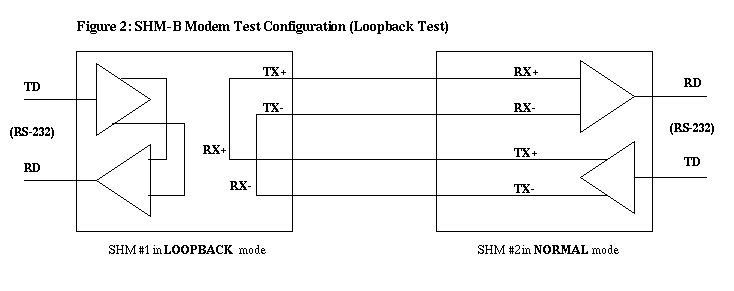
In all cases the SHM are connected directly between a computer (DTE) and a GPS receiver (DCE). SHM-NPR/RJ uses the power available from the RS-232 connector on the Data Terminal Equipment (DTE) (also called Data Communication Equipment (DCE) or computer) and is used with the following receivers:
Trimble 4000SSE/SSi
Ashtech Z-XII
AOA TurboRogue
| Data Rate (bps) |
SHM-NPR/RJ Distance (miles / kilometers) |
| 19,200 | 1.0 / 1.6 |
| 9600 | 2.2 / 3.5 |
| 4800 | 3.5 / 5.6 |
| 2400 | 4.5 / 7.2 |
The SHM-NPR/RJ is an asynchronous full-duplex 4 wire line driver/receiver. Optimum performance is achieved using twisted pair cable without shielding. On the SHM-NPR/RJ an in-line RJ-11 surge protector is highly recommended.
Note: The above specifications are valid for 24- or 26- AWG unloaded and unshielded twisted pair telephone cable insulated by polyethylene with a mutual capacitance of 0.083 micro-f/mile. Shielded twisted pair cable will reduce the distance to one-third of the table value, due to the additional capacitance contributed by the cable’s shielding. Actual distances may vary, depending on your specific operating equipment and the cable you use. (From Black Box Corporation SHM-B Async Manual).
Communication protocol: Asynchronous
Operation: 4 wire, full duplex, point to point
Equipment interface: Serial EIA RS-232C/CCITT v.24 interface with hardware flow control. Interface is switch-selectable for DTE/DCE configuration (pins 2 and 3 reversed).
Connectors: One DB25 (socket or pins, ME821A-F-R2 or ME821A-M-R2), one RJ-11 female.
Power: From RS-232 interface (+12 V DTR/DSR, 6.3 mA)
Operating temperature: 32 deg to 112 deg F (0 deg to 45 deg C)
Humidity: 95% max (non-condensing)
The unit’s DB25 connector either plugs directly into the computer or receiver serial port, or a DB9-DB25 adapter may have to be used. The SHM-NPR/RJ is powered by the attached device’s RS-232 signals. The twisted pair RJ-11 wire plugs into the RJ-11 female port. The SHM-NPR/RJ can not be used with regular telephone lines. If the unit is used as a DCE set the DCE/DTE switch to DCE. If the unit is used as a DTE set the switch to DTE. This is true when using a straight cable. When using a null-modem cable reverse the DCE/DTE settings on the SHM-NPR/RJ.
Make sure the twisted pair wire is connected properly, see Figure 1 for the SHM-B modem. On the SHM-B do a test using the Loopback modem (see Figure 2) to verify the RS-232 cable wiring and the DCE/DTE switch (S1) setting. In the Loopback mode characters typed on the keyboard should be echoed back to the screen from the modem. Both SHM-B units have to be powered up for regular communication to work. If the Loopback test is error free there could be a problem with the twisted pair wire. Exceeding the recommended distance may cause occasional data errors. Try a higher quality four wire twisted cable or reduce the communication distance to where the data quality is consistently good. Also, check for sources of electrical interference that can create noise and data errors in the transmissions. Crosstalk between two or more four wire cables are also a potential error source.


Send questions or comments to Support (support![]() unavco.org).
unavco.org).
Article ID: 343
Created: January 19, 2009
Last Updated: January 19, 2009
Author: Beth Bartel
Online URL: https://kb.unavco.org/article/shm-npr-rj-modem-summary-343.html